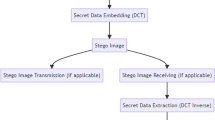Abstract
The existed digital steganography models and theories are not effective enough to guide the steganography processing. Based on previous studies, this paper proposes a complete digital steganography model based on additive noise. And then, with security analysis from KL divergence, the embedding optimization strategy is given through theoretical derivation needless of any side information: optimizing the embedding modification position and optimizing the embedding modification direction (+1 or − 1). Through theoretical derivation, we also obtain the quantitative relationship between the pixels modification probability and the adjacent pixels difference, and prove that modification by ±1 randomly cannot enhance steganographic security definitely. The research in this paper can provide theoretical guidance for the design of steganography algorithms. Compared with previous studies, the proposed embedding optimization strategy has outstanding advantages of being easy to implement and being effective to improve steganographic security. The experiments by optimizing LSBM and MG algorithms show that the proposed embedding optimization strategy can effectively improve each algorithm’s steganographic security at a relative small payload.






Similar content being viewed by others
References
Bas P, Filler T, Pevný T (2011) Break Our Steganographic System: The Ins and Outs of Organizing BOSS. Information Hiding. Springer Berlin Heidelberg, pp. 59–70
Denemark T, Fridrich J (2015) Improving Steganographic Security by Synchronizing the Selection Channel. ACM, pp. 5–14, https://doi.org/10.1145/2756601.2756620
Denemark T, Fridrich J (2015) Side-informed steganography with additive distortion. IEEE International Workshop on Information Forensics and Security. IEEE, pp. 1–6, https://doi.org/10.1109/WIFS.2015.7368589
Denemark T, Fridrich J (2017) Model Based Steganography with Precover. Electronic Imaging 2017(7):56–66. https://doi.org/10.2352/ISSN.2470-1173.2017.7.MWSF-326
FILLER T, FRIDRICH J (2010) Gibbs construction in steganography. IEEE Transactions on Information Forensics and Security 5(4):705–720. https://doi.org/10.1109/TIFS.2010.2077629
Filler T, Judas J, Fridrich J (2010) Minimizing embedding impact in steganography using trellis-coded quantization. Proceedings of SPIE - The International Society for Optical Engineering 6(1):175–178. https://doi.org/10.1117/12.838002
Fridrich J (2015) Content-adaptive pentary steganography using the multivariate generalized Gaussian cover model. Proceedings of SPIE - The International Society for Optical Engineering, 9409: 94090H-94090H-13, https://doi.org/10.1117/12.2080272
Fridrich J, Kodovský J (2012) Rich Models for Steganalysis of Digital Images. IEEE Transaction on Information Forensics and Security 7(3):868–882. https://doi.org/10.1109/TIFS.2012.2190402
Fridrich J, Kodovský J (2013) Multivariate gaussian model for designing additive distortion for steganography. IEEE International Conference on Acoustics, Speech and Signal Processing. IEEE, pp. 2949–2953, https://doi.org/10.1109/ICASSP. 2013. 6638198
Ker AD (2009) Estimating Steganographic Fisher Information in Real Images. Information Hiding, International Workshop, Ih 2009, Darmstadt, Germany, June 8–10, 2009, Revised Selected Papers. DBLP, pp. 73–88, https://doi.org/10.1007/978-3-642-04431-1_6
Kodovsky J, Fridrich J, Holub V (2012) Ensemble Classifiers for Steganalysis of Digital Media. IEEE Transactions on Information Forensics & Security 7(2):432–444. https://doi.org/10.1109/TIFS.2011.2175919
Li B, Tan S, Wang M, et al (2015) A strategy of clustering modification directions in spatial Image steganography. Information Forensics and Security, IEEE Transactions on, 10(9):1905–1917, https://doi.org/10.1109/TIFS.2015. 2434600
Luo X, Song X, Li X et al (2016) Steganalysis of HUGO steganography based on parameter recognition of syndrome-trellis-codes. Multimedia Tools & Applications 75(21):13557–13583. https://doi.org/10.1007/s11042-015-2759-2
Ma Y, Luo X, Li X et al (2018) Selection of Rich Model Steganalysis Features Based on Decision Rough Set α-Positive Region Reduction. IEEE Transactions on Circuits & Systems for Video Technology PP(99):1. https://doi.org/10.1109/TCSVT.2018.2799243
Sedighi V, Cogranne R, Fridrich J (2015) Content-Adaptive Steganography by Minimizing Statistical Detectability. IEEE Transactions on Information Forensics & Security 11(2):221–234. https://doi.org/10.1109/TIFS.2015.2486744
Sun Y, Niu D, Tang G et al (2012) Optimized LSB Matching Steganography Based on Fisher Information. J Multimed 7(4):295–302. https://doi.org/10.4304/jmm.7.4.295-302
Xi L, Ping XJ, Zhang H (2011) Security Analysis of Adaptive Steganography Basedon Gaussian Mixture Model. Journal of Information Engineering University 12(3):333–337
Yang C, Luo X, Lu J, Liu F (2018) Extracting hidden messages of MLSB steganography based on optimal stego subset. SCIENCE CHINA Inf Sci 61(11):1–3. https://doi.org/10.1007/s11432-017-9328-2
Zhang Y, Qin C, Zhang W et al (2018) On the Fault-tolerant Performance for a Class of Robust Image Steganography. Signal Process 146:99–111. https://doi.org/10.1016/j.sigpro.2018.01.011
Author information
Authors and Affiliations
Corresponding author
Additional information
Publisher’s Note
Springer Nature remains neutral with regard to jurisdictional claims in published maps and institutional affiliations.
Rights and permissions
About this article
Cite this article
Song, HT., Tang, GM., Kou, G. et al. Digital steganography model and embedding optimization strategy. Multimed Tools Appl 78, 8271–8288 (2019). https://doi.org/10.1007/s11042-018-6810-y
Received:
Revised:
Accepted:
Published:
Issue Date:
DOI: https://doi.org/10.1007/s11042-018-6810-y




